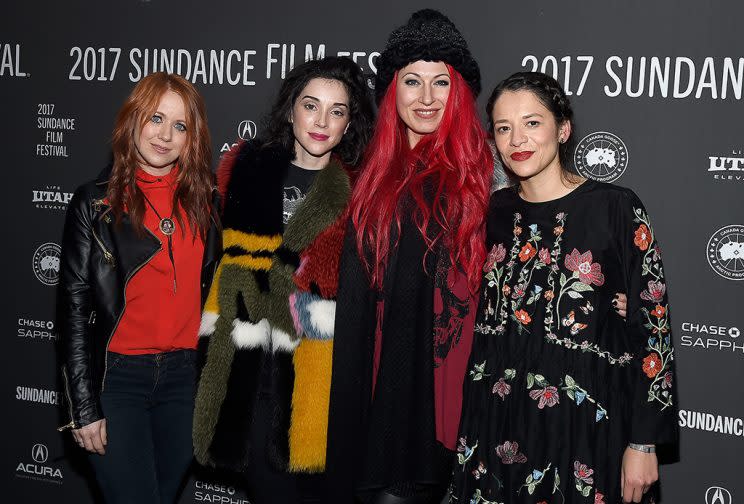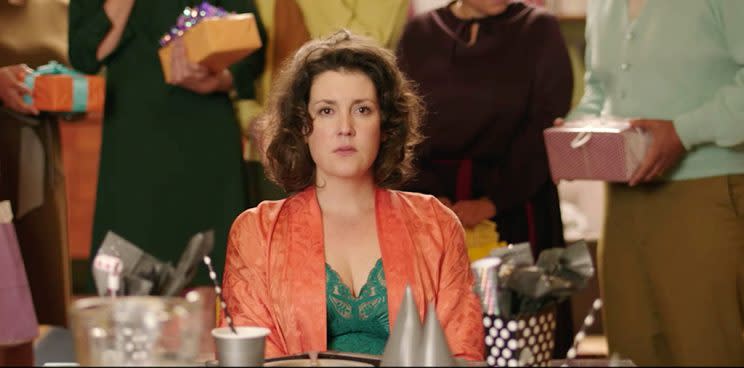‘XX’ Files: The All-Female Director Troupe Spill the Gory Details Behind the New Horror Anthology Film

Warning: This post contains spoilers for four of the five chapters of the anthology horror film XX.
It hasn’t gone unnoticed among genre fans that women have become the most dedicated audience for horror movies around. But that passion for scary movies hasn’t translated into increased opportunities behind the camera for female filmmakers. For every Babadook (directed by Jennifer Kent), the majority of horror assignments still go to men. That’s even true of popular horror anthologies like V/H/S, which would seem to have plenty of assignments to divvy up equally between male and female directors.
Rather than wait around for an overdue invitation to join the horror movie boys’ club, a quintet of women decided to collaborate on their own omnibus collection of spooky stories. The result is XX, which premiered at the Sundance Film Festival last week ahead of its theatrical and VOD release on Feb. 17. The ringleader of this bloody circus is Jovanka Vuckovic, a Toronto-based filmmaker who had the idea for a female-led horror anthology roughly four years ago and originally planned to finance it via Kickstarter until producer Todd Brown stepped in. “Todd called me and asked me if I wanted to be involved and reach out to other female directors. He also said, ‘I can bring financing,’ which was music to my ears!”
Vuckovic immediately set about enlisting fellow directors in this shared cause, whose ranks grew to include Roxanne Benjamin, Annie Clark, animator Sofìa Carrillo, and Karyn Kusama, the director of last year’s critically acclaimed horror-laced thriller The Invitation. And when Brown’s original financing fell through, he connected Vuckovic with Magnet Releasing, the genre arm of Magnolia Pictures, which previously released the V/H/S series as well as The ABCs of Death. “They gave us complete creative control,” Vuckovic says. “This particular combination of directors turned out to be magic.”
During an especially snowy day at Sundance, while blizzard conditions raged by outdoors, Yahoo Movies spoke with four of the five directors (Kusama was unable to attend) to discuss the inspiration behind each of their individual segments.

Jovanka Vuckovic, “The Box”
Vuckovic found inspiration in a popular short story penned by genre novelist Jack Ketchum. Originally published in 1994, “The Box” unfolds from the perspective of a distant father as he watches his son — followed by his entire family — waste away due to a self-imposed starvation diet after the boy peeks inside a box carried by a mysterious stranger. For her adaptation, Vuckovic changed the primary point of view character from Dad to Mom (played by Natalie Brown), a shift that subtly alters the thematic underpinning of the story. Instead of a tale of a father’s isolation, it becomes the story of a mother’s sacrifice, an idea that’s driven home in a hallucinatory scene created especially for the film in which Mom offers up her own body to her starving family for a pre-Christmas feast.
I read “The Box” years ago, and when the opportunity to make XX came around, I said, “I’ve always wanted to see somebody do ‘The Box’ — why not me?” It’s the same story, but the maternal stuff is new. [Motherhood] can be grueling, and not a lot of people expect that when you decide to have a baby and a family. The drudgery of routine: getting up at 7 a.m. every day to make lunches and drive your kids to school. I’ve met a lot of women who resent being mothers. My mother resents being a mother. There’s another person I know who had two kids, and she told me, “I don’t know why I did this, because I can’t stand them. Every day I get up and serve them, and I feel like they’re eating me alive.”
That was the exact feeling that [inspired] the cannibalism scene. I wanted it to resemble Christmas dinner, only instead of a turkey, here’s Mom all flayed. I asked Jack Ketchum for permission to add that. Not all women are meant to be mothers, and this is a story about one who isn’t very good at it. And her natural inability to be a good mother and make a connection with her children is what saves her from whatever’s in the box.
At the same time, it’s also what torments her, because by the time she realizes she misses them, it’s too late. I think that happens with a lot of parents and children. They get to a certain age, and you have to give to get something out of your kids. You can’t just be ambivalent toward them your whole life and expect them to love you on your deathbed.

Annie Clark, “The Birthday Party”
For her directorial debut, the musician known as St. Vincent collaborated with Roxanne Benjamin on a horror short that’s structured like a joke. The setup involves a housewife (Melanie Lynskey) waking up on the morning of her daughter’s birthday party to discover that her husband died during the night. Without time to properly dispose of the body, she does her best to keep it hidden even as young guests start arriving for the festivities. Her hard work pays off — kind of — in a hilariously horrific punch line.
The whole idea had to do with high stakes; that’s always the key to making something compelling. In this case, the high stakes are protecting a child from horrible news and the absurd lengths someone will go to do that. And then it ultimately fails anyway, which is just funny to me. Figuring out who is going to be the dead body was really fun. It had to be this stuntman, who acted as a weight ventriloquist and helped Melanie move him around. He was, like, a 200-pound dude! We also used sound design to put exclamation points on the all the jokes and scares.
You have to support all this kind of material with tone and style, so there was a lot of attention to the way everything looked, from the midcentury house to the stylized hair everyone had. That really helped put the story in a very specific world and made the situation a little bit easier to buy into — that this woman would make these decisions. Like, “We’re really hoping for the best for her, but it isn’t looking good!”

Roxanne Benjamin, “Don’t Fall”
Every horror anthology needs a hard-charging monster segment, and that’s what Benjamin set out to make with “Don’t Fall,” in which a group of campers step on sacred ground and awaken a bloody-minded spirit. It was the last segment to be shot prior to the Sundance deadline, so Benjamin had a limited time frame to make her monster movie a reality. But she welcomed the challenge of generating scares on a short production schedule.
I actually think that [having less time] benefits the creative process. You don’t have any time to second-guess yourself. It’s like, “These are the decisions — let’s go!” I 100 percent wanted to do a jump-scare monster movie, the kind of straight-down-the-middle pulpy stuff I grew up with as a kid. The last film I directed [the “Siren” segment of the 2015 horror anthology Southbound] was deeply rooted in inter-relational horror, almost in the form of gaslighting. With this one, I wanted to make it more action-oriented; you’re out in the middle of nowhere and something is coming to get you because you’re somewhere you’re not supposed to be. Growing up around the campfire as a kid, I wanted to tell a serious campfire tale.
I worked with the team at Russell FX, who did Southbound with me, for the monster design. I didn’t want to focus on this, but the idea was that the monster becomes a part of the place. You’re slowly turning into the place and have to become the protector, which means destroying those around you. It’s how the familiar becomes the unfamiliar, and the people you know become the people you don’t know. I wanted the monster to look like a part of the desert — the grayness and colorlessness of it.

Sofìa Carrillo, animated segments
Filling in the gaps between films are beautifully crafted stop-motion sequences overseen by Carrillo, a Mexican-born artist who cites stop-motion artists like Jan Svankmajer and the Brothers Quay as inspiration. Taken together, these interstitials do tell a cohesive story, about a girl trying to bring her best friend back to life.
I knew that I wanted this to tell a tiny tale; I didn’t want it to be an interstitial without any knitting. After so many adventures, I finally came up with a [story] that has to do with the energy of objects, but also [resurrection]. I wanted to tell this story with puppets and fabric — feminine things. It was also very important to me to use a real person [for some scenes], because the shorts were live-action. And, in some way, I had to connect this story with the real world.

